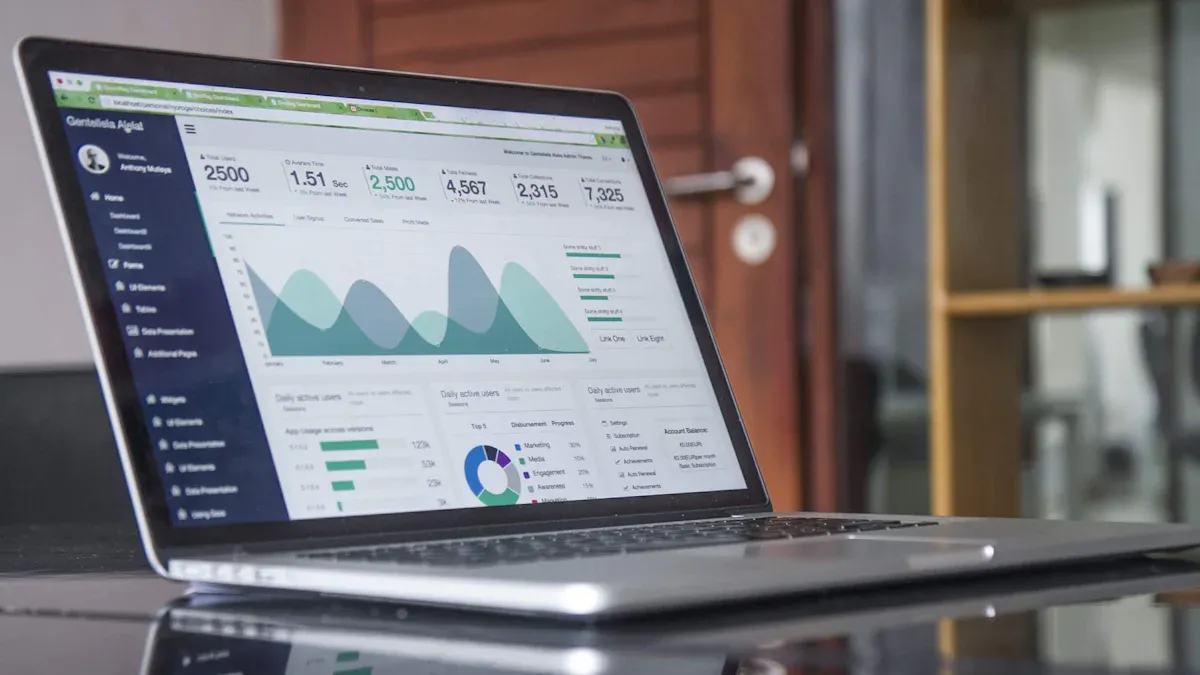Power BI and Lakehouse integration

You can connect Power BI with Lakehouse architectures to make analytics better. This link helps your reports work faster by moving data changes to the Lakehouse. It also lets you see updates right away in your reports. You get one place to handle both organized and messy data, so your work is easier and faster. Lakehouse architectures help you spend less money and give you more choices for new analytics and AI work.
Better speed with native pushdown and direct query models
Easier data handling and teamwork
Real-time use and quick updates for business intelligence
Key Takeaways
Using Power BI with Lakehouse makes reports faster. You can see data updates right away. This helps you work with data quickly and easily.
Lakehouse lets you use many types of data. You can look at structured, semi-structured, and unstructured data together.
Pick the best way to connect Power BI. Use DirectLake Mode for speed. Use Lakehouse Connector if you need more options. This helps you get better results.
Set up strong security to keep data safe. Use role-based access control. Check permissions often to protect important data in Power BI and Lakehouse.
Follow good steps for data models and tuning. This makes your reports work better. It also helps your data refresh on time.
Lakehouse Overview

What Is a Lakehouse
You might ask how a Lakehouse is not the same as other data systems. A Lakehouse mixes things from data warehouses and data lakes. You can keep different kinds of data here. This includes structured, semi-structured, and unstructured data. You can store things like spreadsheets, pictures, and logs together. Lakehouse architectures let you work with data in groups or as soon as it comes in. Your data stays safe because Lakehouses use ACID compliance. This keeps your data protected and trustworthy.
Take a look at this table to see how Lakehouse is different from older systems:
Characteristic | Lakehouse Architecture | Data Warehouse | Data Lake |
|---|---|---|---|
Data Types | Structured, semi-structured, unstructured | Structured only | Structured, unstructured, semi-structured |
Data Processing | Supports both batch and streaming | Primarily batch processing | Primarily batch processing |
ACID Compliance | Yes | Yes | No |
Analytics Capabilities | Integrated analytics capabilities | Optimized for analytics | Limited analytics capabilities |
Storage Layer | Typically cloud object storage | Optimized storage for structured data | Low-cost storage for all data types |
Metadata Management | Unified catalog for metadata | Limited metadata capabilities | Basic metadata management |
Scalability | Compute and storage resources are separate | Limited scalability | High scalability |
Integration with Existing Systems | Can integrate with existing lakes and warehouses | Standalone system | Standalone system |
Tip: You can use a Lakehouse with your current data lakes and warehouses. This means you do not need to start over.
Role in Analytics
Lakehouse architectures are important for modern analytics. You can use business intelligence tools like Power BI right on your main data. This makes building reports and dashboards easier. You do not have to move data around. You get answers faster, so you can make smarter choices.
You can work with many types of data. This gives you a full picture of your business.
Lakehouses let you process data in groups or right away. You can study data as soon as it shows up.
You can bring in data from lots of places. This helps you learn more.
Lakehouses help with advanced analytics too. You can do predictive analytics, sentiment analysis, and find strange patterns. Real-time reporting helps you see trends and problems quickly. Data scientists and machine learning experts use Lakehouses for many jobs. The system works for different tasks.
Note: Using a Lakehouse makes your analytics faster and more flexible. You can react to changes in your data right away.
Power BI Integration Methods

You can connect Power BI to a Lakehouse in different ways. Each way has special features and benefits. You should pick the one that works best for you. Here are the main choices you have:
DirectLake Mode
DirectLake Mode lets Power BI connect straight to your data in OneLake. You do not need to move or copy anything. This is good if you want fast access to big datasets. You can use raw files and tables in your Lakehouse. DirectLake Mode lets you mix tables from different storage types.
Consideration / Limitation | Direct Lake on OneLake | Direct Lake on SQL (analytics endpoint) |
|---|---|---|
Composite modeling | Supported | Not supported |
Complex Delta table types | Not supported | Not supported |
String column length | 32,764 Unicode chars | 32,764 Unicode chars |
Non-numeric float values | Not supported | Not supported |
Matching data types for relationships | Yes | Yes |
Note: DirectLake Mode does not work with complex Delta table columns or calculated columns. You might get errors if there are duplicate values in related columns.
DirectLake Mode is in public preview right now. You should check your tenant settings before using it. This way is fast and works well with lots of data.
Lakehouse Connector
The Lakehouse Connector helps you link Power BI to your Lakehouse easily. You can use it for Delta tables and other data types. It works with both import and DirectQuery modes. You get better speed when you use Delta tables.
Feature | Lakehouse Connector for Power BI | Other Integration Methods |
|---|---|---|
Performance | Varies by method | |
Direct Lake Mode | Loads directly from data lake | Requires endpoint queries |
Import Mode | Available | Available |
DirectQuery | Supported | Supported |
You can use the Lakehouse Connector with Microsoft Fabric and Databricks Lakehouse. It works with both organized and messy data. You can also use Spark for data jobs before you connect.
You can use raw files in the
/Filesfolder or clean data in the/Tablesfolder.The connector lets you do cross-database queries, so you can build more business rules.
Tip: The Lakehouse Connector makes it easy to bring your Lakehouse data into Power BI for analysis.
SQL Endpoint
The SQL Endpoint lets you use SQL queries to get your Lakehouse data. You can use this if you want to work with data in the /Tables folder. The SQL Endpoint is read-only, like a warehouse. You can use it to make reports and dashboards in Power BI.
Here is how you can set up access:
Open your Lakehouse in the workspace.
Click the three dots next to it.
Pick 'Share' from the menu.
Type the email of the person who needs access.
Give permissions like 'Read all SQL endpoint data' or 'Build reports on the default semantic model'.
Make sure the person has the right permissions to connect.
You can also use row-level, object-level, and column-level security to keep your data safe. The SQL Endpoint lets you do cross-database queries, so you can switch between datasets easily.
Feature | Databricks | Microsoft Fabric |
|---|---|---|
Semantic Model | Unity Catalog integration | Fully integrated with Power BI |
Database Connector | Import and DirectQuery modes | No extra setup needed |
Storage | SQL Data Warehouse, Delta Lake | SQL Warehouse, OneLake |
Compute Layer | Serverless compute for SQL | Auto-scaling and fixed capacity |
Governance and Lineage | Unity Catalog | Microsoft Purview |
Contextual Reasoning and AI | Genie for natural language | Copilot (not fully enterprise-ready) |
Note: The SQL Endpoint works with Databricks Lakehouse and Microsoft Fabric. You can use it to study data in any Lakehouse that supports SQL endpoints.
You can pick the way that works best for you. DirectLake Mode is fast. The Lakehouse Connector is flexible. The SQL Endpoint gives you control and safety. All these ways help you use your Lakehouse data in Power BI.
Integration Steps
Prerequisites
Before you connect, you need some things ready. You must have access to a Microsoft Fabric workspace with a lakehouse. You need Power BI Desktop on your computer. You should upload Excel or CSV files to your lakehouse. Make sure you have the right permissions to use the lakehouse and its files.
Tip: Check your permissions first. This helps you avoid mistakes later.
Setup Process
You can use the Lakehouse connector to set up your connection. Here are the steps to follow:
In your workspace, click New item at the top.
On the screen, search for or pick Lakehouse.
Type a name for your lakehouse, like SalesLakehouse, and click Create.
In the editor, click New Dataflow Gen2 in the ribbon.
Give your dataflow a name, like OnlineSalesDataflow, and click Create.
In the Power Query Online editor, click Import from a Power Query template and pick your file, like ContosoSales.pqt.
Click the DimDate query and set up the connection.
Change the DateKey column to the Date/Time type.
Check and set where to put data for DimDate and FactOnlineSales.
Save and run your dataflow.
Make a new data pipeline and set it to refresh your dataflow by itself.
Note: You can also use the SQL endpoint to connect. You will need the SQL connection string from your Lakehouse settings.
Data Access
It is important to control who can see your data. You should use good rules to keep your data safe.
Description | |
|---|---|
Principle of Least Privilege | Give each user only the access they need. |
Regular Reviews | Check and fix permissions often to keep them right. |
User Training | Teach users how to keep data safe and handle private information. |
Documentation | Write down your permission rules, roles, and security plans. |
To connect Power BI to your Lakehouse with the SQL endpoint, do these steps:
Step | Description |
|---|---|
1 | |
2 | In Power BI Report Builder, make a data source and pick the connection type and method. |
3 | Paste the SQL endpoint and pick Azure Active Directory for login. |
4 | Use the SQL data source to make a new dataset and run SQL queries. |
Tip: Always use safe ways to log in when you connect to your data.
Troubleshooting
Sometimes, you might have problems when you connect Power BI to your Lakehouse. Here are some common problems and how to fix them:
The 'Integrated Security Not Supported Error' can happen when you use a Lakehouse with a Notebook.
This problem usually means there is a setup or permission issue with your Lakehouse and Notebook.
Try checking your Lakehouse settings or make a new Notebook to see if it works.
Note: If you still have trouble, check your permissions and settings again. Make sure you have the newest Power BI Desktop installed.
Integration Benefits
Performance
When you connect your Lakehouse to Power BI, reports load faster. You can look at data more easily. Studies show Direct Lake works well with small datasets. You get quick results and do not wait long. If you use big datasets or many users, things can slow down. The system might switch to DirectQuery mode. This can make delays and sometimes cause timeouts. Direct Lake loads data only when needed. It is best for small, live data queries. For big data, you should expect slower speeds.
Tip: Check your data size before picking a connection mode. This helps you avoid slow reports.
Scalability
Lakehouse architecture lets your data system grow easily. It works with all types of data. You get real-time analytics. You do not need to spend more money as your data grows. Old data warehouses are good for structured data. They cost more and slow down as they get bigger.
Architecture Type | Scalability Advantages | Scalability Limitations |
|---|---|---|
Lakehouse | N/A | |
Traditional Data Warehouse | Good for structured data, but limited for other types | Needs lots of money as data grows |
Lakehouses let you add new data sources and users easily.
Real-Time Analytics
You can see live data and make choices fast. Microsoft Fabric helps with real-time data processing. You get live dashboards and reports in Power BI. Direct Lake Mode connects you to your Lakehouse for fresh reports. Event Streams handle live data and help build real-time dashboards.
Feature | Description |
|---|---|
Real-Time Data Processing | Microsoft Fabric supports live dashboards and reports in Power BI. |
Direct Lake Mode | Connects Power BI to Lakehouse for real-time queries. |
Event Streams | Processes live data for real-time dashboards in Power BI. |
Simplified Architecture
Lakehouse integration gives you a simpler data system. You get one source of truth. Everyone sees the same data. You do not need extra pipelines or complex setups. Reports update automatically, so you always see the newest numbers. Organizations save over 50% after switching. Some big companies save more than 75%. You spend less on copying data, moving data out, and computing.
You save money by making fewer copies of data.
You do not argue about which data is right.
You make your analytics easier to manage.
Note: A unified Lakehouse makes analytics faster, cheaper, and easier to use.
Challenges and Solutions
Data Latency
Sometimes, you might not see the newest data in Power BI. This is called data latency. It can make your reports and dashboards slow. Slow connectors, lots of data, or fast-changing data can cause this. You can fix these problems with some easy steps.
Use a middle layer like Azure SQL or Microsoft Fabric Lakehouse. This helps move data faster and cuts down wait times.
Set up automatic data refresh with Power Automate or Azure Data Factory.
Turn on Incremental Refresh or DirectLake in Power BI. This updates only new data, not all data.
For live data, use Push Datasets or Streaming Datasets in Power BI.
Here is a table that lists common latency problems and how to solve them:
Data Latency Challenge | Solution |
|---|---|
Low-latency use cases need careful design | Use a middle layer for data integration |
Streaming capabilities vary across platforms | Use special data processing techniques |
Debugging live flows is complex | Combine batch and stream processing |
Sub-second response times are needed | Add in-memory stores for faster performance |
Tip: Do not use the Business Central connector by itself. It can make your reports slow or cause timeouts.
Security
Security matters a lot when you connect Power BI to a Lakehouse. You need to keep private data safe and control who can see it. Lakehouse connections need stronger security than some other sources. You should use Row-Level Security for private data. Watch user permissions closely. Power BI uses your login to give you access to the Lakehouse. Your role decides what you can see.
Aspect | Lakehouse Connection | Other Data Sources |
|---|---|---|
Row-Level Security | Required for sensitive data | Not always required |
Permissions | Needs careful user access management | Standard permissions may work |
Authentication | Passes end-user credentials to Lakehouse | May not need re-authentication |
Data Access | Direct, based on user credentials | Cached, may not use user credentials |
Check and update permissions often.
Teach users how to keep data safe.
Note: DirectLake needs different permissions than older sources. Set up security before you share reports.
Compatibility
You may have problems when you connect Power BI to different Lakehouse systems. Sometimes, Power BI Desktop gives errors like "Integrated Security not supported." This happens if your connection method is not right for the Lakehouse. You can fix this by checking your settings and using the right login method.
Issue Title | Description | Solution Status |
|---|---|---|
Power BI Desktop Connection Issue: Integrated Security Not Supported | Error appears when connecting Power BI Desktop to Lakehouse: 'Integrated Security not supported.' | Solved |
If you get connection errors, update Power BI Desktop and check your login settings. Most problems are easy to fix.
Best Practices for Power BI
Data Models
You can make strong data models by picking good storage modes. Fact tables work best with DirectQuery. This mode sends questions right to your Lakehouse. You get answers faster this way. Dimension tables do well with Dual storage mode. Dual mode lets you use cached data or live queries. This helps you use resources in a smart way. You should use the Databricks SQL engine when building models. This engine makes your queries run better and can handle lots of data.
Best Practice | Description |
|---|---|
This mode allows you to submit queries directly to Databricks SQL, enhancing performance. | |
Use Dual storage mode for dimension tables | Dual mode lets you choose between cached data and querying the source, optimizing efficiency. |
Leverage Databricks SQL engine | Using this engine improves SQL query generation and scalability, ensuring optimal performance. |
Tip: Choose the best storage mode for each table. This makes your reports faster and keeps your data up-to-date.
Security Management
You need to keep your data safe at every step. Security starts at the OneLake layer and goes through workspaces and Lakehouses. Workspace security lets you control who can see and use your data. Role-based access control makes sure only the right people get in. You can set permissions for each schema or table. This keeps private data safe. Governance policies help you follow rules and protect your data.
Aspect | Description |
|---|---|
Role-Based Access Control | Ensures only authorized users can access specific datasets. |
Permissions Management | Allows setting permissions for lakehouse schemas or tables, limiting access to sensitive data. |
Governance Policies | Establishes rules to protect sensitive data and ensure compliance with regulations. |
Use data encryption.
Track where your data comes from for rules.
Note: Always check permissions and update them when people change jobs or leave.
Performance Tuning
You can make your reports faster by doing a few things. First, clean up your data model. Remove columns and tables you do not need. Next, use the right storage modes and aggregations. Aggregations help you sum up data and speed up questions. Make your DAX measures work fast and well. Set up incremental refresh to update only new data.
Clean up your data model
Use the right storage modes and aggregations
Make DAX measures faster
Set up incremental refresh
Efficient data refresh keeps your data current without slowing things down. You can use schedules, adjust how many things run at once, and make your source queries better for the best results.
You can get better analytics when you connect your lakehouse to reporting tools. Many companies do well by following simple steps. They match their business goals, clean their data, and make strong models.
Description | Advantages | |
|---|---|---|
DirectLake | Reads from OneLake for live reports. | Stops extra copies, works with big datasets. |
DirectQuery | Connects to datasets for almost live analytics. | Lets you explore data without importing everything. |
Import Mode | Good for small or medium datasets with set refresh times. | Gives fast answers from saved data. |
Use good habits and try these ways to connect. This helps you get the most from your data.
FAQ
How do you connect Power BI to a Lakehouse?
First, open Power BI Desktop. Pick the Lakehouse connector. Type in your workspace details. You can also use the SQL endpoint for more options. Always check your permissions before you begin.
Can you use real-time data with Power BI and Lakehouse?
Yes, you can use real-time data. DirectLake Mode and Event Streams show live data in reports. You see updates right when new data comes to your Lakehouse.
What types of data can you analyze in a Lakehouse?
You can use structured, semi-structured, and unstructured data. This means you can work with tables, logs, images, and files. Lakehouse lets you study many kinds of data for your needs.
Is it safe to use Power BI with Lakehouse data?
Yes, it is safe if you set up security rules and permissions. You decide who can see or change the data. Power BI uses row-level security and checks user logins.
What should you do if you see a connection error?
Make sure your Power BI is up to date. Check your login details. If you still have problems, look at your Lakehouse permissions and try again.
See Also
Enhancing Dataset Freshness by Linking PowerBI with Singdata Lakehouse
The Role of Lakehouse in Modern Data Environments Explained
A Comprehensive Guide to Safely Connect Superset with Singdata Lakehouse

